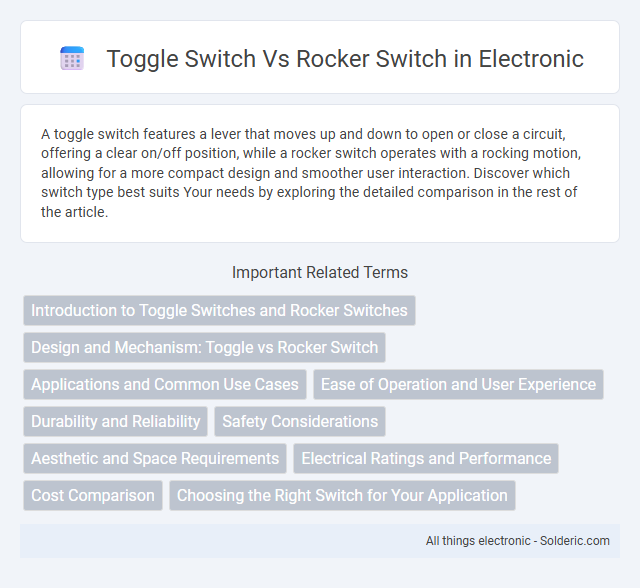A toggle switch features a lever that moves up and down to open or close a circuit, offering a clear on/off position, while a rocker switch operates with a rocking motion, allowing for a more compact design and smoother user interaction. Discover which switch type best suits Your needs by exploring the detailed comparison in the rest of the article.
Comparison Table
| Feature | Toggle Switch | Rocker Switch |
|---|---|---|
| Design | Lever-based actuator that flips up/down | Flat, rocking actuator that pivots back/forth |
| Operation | Manual flip to open or close circuit | Press one side to open/close circuit |
| Application | Common in industrial & automotive controls | Popular in home appliances & power strips |
| Installation | Panel-mounted, requires cutout for lever | Flush panel mount, low profile design |
| Durability | Robust, handles higher currents | Moderate durability, standard currents |
| Visual Feedback | Lever position clearly shows ON/OFF state | Side pressed indicates ON/OFF status |
| Cost | Generally higher due to mechanical parts | Cost-effective for mass-market devices |
Introduction to Toggle Switches and Rocker Switches
Toggle switches feature a lever that moves up and down or side to side to control electrical circuits, widely used for their durability and tactile feedback in industrial and automotive applications. Rocker switches operate by rocking a raised or recessed actuator back and forth, offering a compact and ergonomic design favored in household appliances and electronic devices. Both switch types provide reliable manual control, with toggle switches often preferred for their clear ON/OFF indication and rocker switches valued for their low-profile installation.
Design and Mechanism: Toggle vs Rocker Switch
Toggle switches feature a lever that pivots up or down to open or close circuits, offering a clear visual indication of the switch position. Rocker switches utilize a rocking mechanism where pressing one side of the switch actuates the connection, providing a low-profile and ergonomic design ideal for modern electronic devices. The distinct mechanical actions influence their durability and tactile feedback, with toggle switches favored in industrial settings and rocker switches common in consumer electronics.
Applications and Common Use Cases
Toggle switches are widely used in industrial machinery, automotive controls, and lighting systems due to their easy on/off functionality and durability in harsh environments. Rocker switches are commonly found in household appliances, power strips, and audio equipment where a quick and clear indication of the switch position is essential. Both switch types cater to various applications but are selected based on specific ergonomic and operational requirements.
Ease of Operation and User Experience
Toggle switches offer a straightforward, intuitive operation with a simple flipping motion that provides clear tactile feedback, enhancing user confidence during use. Rocker switches require less physical effort to activate, making them ideal for applications where ease of use and quick switching are priorities. Your choice between the two should consider the specific context and user interaction preferences to optimize overall user experience.
Durability and Reliability
Toggle switches offer durable mechanical components designed for frequent use, providing reliable on/off functionality under various conditions. Rocker switches feature robust construction with smooth actuation, often rated for high cycle life, ensuring consistent performance over time. Your choice between toggle and rocker switches should consider the specific environmental demands and expected usage frequency for optimal reliability.
Safety Considerations
Toggle switches and rocker switches differ in safety design, with toggle switches often featuring a clear on/off position that reduces accidental activation, while rocker switches provide a more stable and flush profile that minimizes unintentional toggling. Rocker switches typically have built-in illumination for enhanced visibility in low-light conditions, improving user safety during operation. Your choice should consider the environment and application, as rocker switches generally offer better protection against dust and water ingress with sealed designs, making them suitable for harsher settings.
Aesthetic and Space Requirements
Toggle switches often feature a sleek, minimalist design ideal for modern aesthetics, while rocker switches offer a larger surface area that can incorporate illuminated indicators for better visibility in low-light settings. The compact form factor of toggle switches saves panel space, making them suitable for applications with stringent spatial constraints, whereas rocker switches require more room due to their broader profile but provide easier operation with a simple press. Your choice between toggle and rocker switches should consider both the available space and the desired visual appeal to ensure optimal integration with your device or control panel.
Electrical Ratings and Performance
Toggle switches typically offer a wide range of electrical ratings, making them suitable for applications requiring high current and voltage capacities, often up to 20 amps and 250 volts. Rocker switches generally provide reliable performance with lower current ratings, commonly around 10 to 15 amps and 125 to 250 volts, and are favored for their stability and ease of operation in residential and light industrial environments. Your choice between these switches should consider the specific electrical load and switching frequency to ensure optimal durability and safety.
Cost Comparison
Toggle switches generally offer a lower cost compared to rocker switches due to simpler manufacturing processes and widespread availability, making them a budget-friendly option for basic electrical applications. Rocker switches, with their modern design and ergonomic form, often come at a higher price but provide enhanced durability and aesthetic appeal. Your choice between the two should consider the balance between upfront cost and long-term value based on the application requirements.
Choosing the Right Switch for Your Application
Choosing the right switch for your application depends on factors like space constraints, ease of use, and electrical load requirements. Toggle switches offer a quick on/off action ideal for applications needing clear operational status, while rocker switches provide a more compact design and ergonomic operation suitable for panel-mounted devices. Assessing your specific needs ensures you select a switch that enhances functionality and reliability in your system.
toggle switch vs rocker switch Infographic

 solderic.com
solderic.com